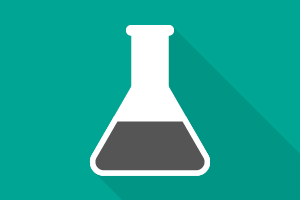Classroom Resources: Chemistry Basics
Filter by:
51 – 75 of 76 Classroom Resources
-

Observations, Density, Physical Properties | Elementary School
Demonstration: Will it Float? Mark as Favorite (1 Favorite)
In this demonstration, students will observe the relationship between the density of a solution and its impact on an object’s ability to float or sink. Uncooked eggs will be placed in a tap water sample and in a salt water solution so that students can make observations and compare the results in order to make a determination regarding the density value for each item.
-

Density, Measurements | High School
Lab: Can it Float? Mark as Favorite (19 Favorites)
In this lab, students will investigate the relationships between mass, volume, density and buoyancy in common objects. Students will be tasked with determining the volume of a variety of objects as well as interpreting the meaning of their buoyancy in water.
-

Gas Laws, Sublimation, Ideal Gas, Volume, Temperature, Pressure, Density, Phase Changes, Interdisciplinary, Density, Physical Change, Mole Concept, Dimensional Analysis, Measurements | High School
Demonstration: Ideal Gas Law using Carbon Dioxide Mark as Favorite (15 Favorites)
In this demonstration, students observe dry ice sublime while the CO2 gas fills a balloon. They then calculate the moles and volume of CO2 produced.
-

Mixtures, Chemical Change, Physical Change, Observations, Density, Acid Base Reactions, Chemical Change, Mixtures | Elementary School
Lab: Analyzing a Lava Lamp Mark as Favorite (5 Favorites)
In this lab, students create a mixture of oil, water and food coloring, and then add an Alka-Seltzer tablet, to create a homemade lava lamp. Student will record their observations during each step of the process and answer follow-up questions about the chemical and physical changes that took place.
-

Gas Laws, Matter, Density, Density, Temperature, Pressure, Volume, Graphing, Observations, Measurements | High School, Middle School
Lab: Pressure Bottle Mark as Favorite (4 Favorites)
In this lab, students determine the relationship between volume and pressure of a gas and its temperature and address the common misconception that air does not have mass or density.
-

Density, Observations, Inferences, Measurements, Identifying an Unknown, Error Analysis, Scientific Method | High School
Lab: Colors of the Rainbow Mark as Favorite (39 Favorites)
In this lab, students will practice density calculations and put their calculations to test by creating their own density column.
-

Density, Concentration, Solute & Solvent | High School
Lab: Test Tube Challenge Mark as Favorite (47 Favorites)
In this lab, students will be challenged to create a density column, consisting of three distinct layers of sugar-water solution. This is an inquiry lab, where the students must apply their understanding of density and concentration in order to devise a successful plan for creating the column correctly.
-

Density, Dimensional Analysis, Review, Measurements, Accuracy, Accuracy, Experimental Design, Error Analysis | High School, Middle School
Lab: Bowling Ball—Will it Sink or Float in Water? Mark as Favorite (7 Favorites)
In this lab, students will find the density of a bowling ball to determine whether it will sink or float in water.
-

Significant Figures, Measurements, Accuracy, Density, Accuracy, Error Analysis, Error Analysis | Middle School, High School
Lab: Significant Figures and Lab Data Mark as Favorite (101 Favorites)
In this lesson, students will use laboratory equipment of different precision to collect data for several different metals, and then use the data to calculate the density of each. They will then compare their calculated densities to accepted values and determine the combination of equipment that leads to the most accurate calculation of density.
-

Density, Measurements, Graphing, Experimental Design, Scientific Method, Physical Properties, Error Analysis, Significant Figures, Error Analysis | High School
Lab: Investigating the Density of an Irregular Solid Object Mark as Favorite (38 Favorites)
In this lab, students will use common laboratory equipment to devise a method to measure the density of several irregular objects. They will then create a formal laboratory report using both their own data and data from the entire class.
-

Density, Observations, Inferences, Mixtures, Mixtures | Middle School, High School
Demonstration: Density Tubes Mark as Favorite (4 Favorites)
In this demonstration, students will have the opportunity to observe and analyze the density of a solution. Students will interpret their observations as they compare the density of the solution with plastic components.
-

Mole Concept, Dimensional Analysis, Density | High School
Lab: Moles of Food Mark as Favorite (64 Favorites)
In this lab, students will analyze the nutrition label of a variety of foods to find the amount of specific elements in each serving. Students are asked to evaluate and compare the data in a series of questions, in order to convert the values to moles. This lab gives students the opportunity to see the connection between the chemistry mole concept and everyday foods.
-

Gas Laws, Molar Mass, Density, Temperature, Pressure, Volume, Ideal Gas, Physical Change, Observations, Density, Identifying an Unknown, Error Analysis | High School
Lab: Molar Mass of Dry Ice Mark as Favorite (14 Favorites)
In this lab, students will use gas laws to calculate the molar mass of dry ice and then use the information to identify the compound that makes up this substance.
-

Density, Physical Properties, Introduction, Observations, Mixtures | Elementary School
Lesson Plan: What is Density Mark as Favorite (3 Favorites)
In this two-part lesson, students will learn about density through a teacher-led demonstration and a hands-on activity. The demonstration will give students the opportunity to observe the formation of a density tower made from common drinks. Students will then create their own density tower using simple ingredients, and then further investigate differences in density when solid objects are added to the tower.
-

Physical Properties, Density, Observations, Mixtures | Elementary School
Activity: Discovery Tubes Mark as Favorite (1 Favorite)
This is a fun, visual activity for young students. It allows for understanding of fundamental chemistry topics, including mixtures, miscibility, density and viscosity while analyzing a handheld colorful toy.
-

Density, Pressure, Temperature, Volume, Density, Error Analysis, Error Analysis, Measurements | High School
Lab: Gas Density and Relative Molecular Mass Mark as Favorite (3 Favorites)
In this lab, students will quantitatively determine the densities of four gases.
-

Density, Density, Observations, Inferences | High School, Middle School
Demonstration: Qualitative Look at Gas Density Mark as Favorite (6 Favorites)
In this demo, students witness three types of gases and observe their relative densities to air.
-

Phase Changes, Sublimation, Physical Change, Density, Observations, Temperature | Middle School
Lesson Plan: Dry Ice Mark as Favorite (0 Favorites)
In this lesson, students will investigate how dry ice undergoes a phase change from solid to gas, skipping the liquid phase under normal temperature and pressure.
-

Chemical Change, Density, Classification of Reactions, Balancing Equations, Observations, Chemical Change | High School
Demonstration: Preparation of Hydrogen Mark as Favorite (2 Favorites)
In this demo, students witness a single displacement reaction between zinc and sulfuric acid that produces hydrogen gas. The gas is collected via water displacement and ignited.
-

Dimensional Analysis, Mole Concept, Measurements, Density, Identifying an Unknown, Molar Mass | High School
Lab: Chemistry Composition Challenge Mark as Favorite (123 Favorites)
In this inquiry based lab, students will design a method to solve three chemistry problems involving moles, molecules, and density.
-

Exothermic & Endothermic, Specific Heat, Density, Phase Changes | High School
Lab: Chemistry is Cooler Stress Test Challenge Mark as Favorite (67 Favorites)
In this lab, students will design and build a device capable of insulating an ice cube submerged in boiling water for two minutes. In this open-ended inquiry based activity, students will be required to critically think about structure and function of the materials they wish to use to build a device to solve a complex real-world problem. Students must consider the thermal properties of the materials, density, and the need to form a non-permeable barrier between the ice cube and the boiling water.
-

Density, Measurements | Elementary School
Demonstration: Sinking Soda Mark as Favorite (5 Favorites)
In this teacher led demonstration, students will compare their observations when unopened cans of diet and regular soda are placed in a large container of water. They will use their observations to help differentiate between several fundamental chemistry concepts: mass, volume, and density.
-

Density, Identifying an Unknown, Measurements | Elementary School, Middle School
Demonstration: Household Densities Mark as Favorite (6 Favorites)
In this demonstration, students will make predictions about various household materials and whether or not each will sink or float when placed in water. Data will be collected and then used to calculate the density value of each item. Finally students will analyze the relationship between the density value and the observed outcome, and use their knowledge to identify unknown materials.
-

Sublimation, Density, Observations | High School, Middle School
Lab: Dry Ice (High School) Mark as Favorite (30 Favorites)
In this lab, students perform several small experiments using dry ice and record their observations.
-

Density, Observations, Measurements | Middle School, High School
Lab: Penny Boats Mark as Favorite (23 Favorites)
In this lab, students will explore Archimedes’ Principle and how it relates to density. Each student will be given a piece of aluminum foil and asked to design and build a boat that will hold as many pennies as possible without sinking when placed in water.